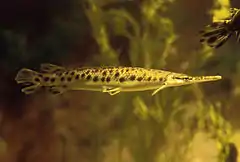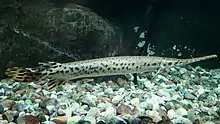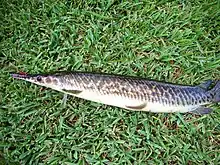| Lepisosteus Temporal range: Early Cretaceous to present[1] | |
|---|---|
 | |
| Longnose gar, Lepisosteus osseus | |
| Scientific classification | |
| Domain: | Eukaryota |
| Kingdom: | Animalia |
| Phylum: | Chordata |
| Class: | Actinopterygii |
| Clade: | Ginglymodi |
| Order: | Lepisosteiformes |
| Family: | Lepisosteidae |
| Tribe: | Lepisosteini |
| Genus: | Lepisosteus Lacepède, 1803 |
| Species | |
|
See text | |
| Synonyms[2][3] | |
| |
Lepisosteus is a genus of gars in the family Lepisosteidae.[4]
Distribution
In Northern Mexico, a new species' fossil was recently discovered from this period, found in marine deposits in Coahuila.[5] This fossil is bizarre because Lepisosteus is known to be a freshwater fish; however, they do have the ability to survive in high salinity, and low oxygen water after gulping air.[5][6] Lepisosteus prefers to reside in brackish and shallow slow-moving waters, living usually in schools.[4] The habitat range of this genus ranges on the Eastern coast from the Gulf of Mexico in Florida north to Quebec. Habitats can be found in the Missouri River Basin and Mississippi River drainage area, westward in the Rio Grande River basin of Southern Texas and Northern Mexico. There are also populations in the Great Lakes except for Lake Superior. Their range can occasionally reach out towards the Mobile Bay, Perdido Bay, and Mississippi Sound.[4][6]
Physical Description & Life Cycle
These fish have ganoid scales on their elongated bodies with a single dorsal fin on the posterior side approximately one inch from their caudal fin.[6] Depending on the clarity of the water, Lepisosteus colors will change. In clear water they can have bright colors of green and silvery-white; alternatively if the water is brackish and cloudy, their colors will be more of a brown hue. [4] Hatchlings are approximately 8-10 mm in size. The average full-grown length of Lepisosteus varies from 34 to 78 inches depending on the species.[6] In comparison to their long snouts, Lepisosteus have relatively small heads; however, their mouths full of sharp teeth.
Lepisosteus is a slow-growing genus generally living a long time. Female gars take 6 years to reach sexual maturity, grow larger, and live up to 22 years. Male gars reach maturity around 3 or 4 years after hatching. The males do not often live longer than 11 years.[6][7] The Longnose Gar will migrate upstream to smaller streams with faster-moving water to spawn and lay eggs.[6] Fish of this genus that are newly hatched will attach themselves vertically to submerged objects by an adhesive disc on their snout. The youth stay attached to the objects until the yolk sac is absorbed which usually takes about 9 days. After the yolk sac of an egg is absorbed, the roe hatches. Hatchlings stabilize to a horizontal position, take their first aerial breath, and begin feeding.
Habitat & Feeding Habits
Because Lepisosteus has evolved to be a top predator, they are voracious eaters that eat a variety of other freshwater fish and crustaceans such as Ictiobus and Blue crabs. Adults will float toward the surface of streams to scout prey that are below them while younger fish in this genus will hide in submersed vegetation to ambush hunt.[8] Studies have found this native North American species is a predator of invasive Asian Carp. The Lepisosteus genus enjoys living in shallow water similar to the habitat of the Invasive Asian Carp.[9] This genus is not generally used for recreational hunting because their roe is toxic to humans. There are no significant threats to these top predators other than habitat loss.[8][10] On the IUCN Red List of Threatened Species, this genus is listed as Least Concerned.[11] The fossil found in Northern Mexico shows that the family once may have been able to live in oceans. The genus consists of four species but cretaceous fossils have shown this family has ancient relatives.[5]
Species
| Lepisosteidae |
| ||||||||||||||||||||||||||||||||||||
The currently recognized species are: Lepisosteus oculatus, Lepisosteus osseus, Lepisosteus platostomus, and Lepisosteus platyrhincus.[10] Three species formerly classified in Lepisosteus (tropical gar, Cuban gar, and alligator gar) are now assigned to the genus Atractosteus.[7]
Species
| Image | Scientific name | Common name | Distribution |
|---|---|---|---|
 | Lepisosteus oculatus Winchell, 1864 | Spotted gar | North America |
 | Lepisosteus osseus Linnaeus, 1758 | Longnose gar | east coast of North and Central America in freshwater lakes and as far west as Kansas and Texas and southern New Mexico |
.jpg.webp) | Lepisosteus platostomus Rafinesque, 1820 | Shortnose gar | Montana to the west and the Ohio River to the east, southwards to the Gulf Coast. |
 | Lepisosteus platyrhincus DeKay, 1842 | Florida gar | USA from the Savannah River and Ochlockonee River watersheds of Georgia and throughout peninsular Florida |
Fossil species
- †Lepisosteus aganus (Cope, 1877)
- †Lepisosteus bemisi Grande, 2010
- †Lepisosteus bohemicus (Laube, 1901)
- †Lepisosteus cominatoi Santos, 1984
- †Lepisosteus cycliferus (Cope, 1873)
- †Lepisosteus glaber Marsh, 1871
- †Lepisosteus indicus Woodward, 1908
- †Lepisosteus integer (Cope, 1877)
- †Lepisosteus fimbriatus Wood, 1846
- †Lepisosteus knieskerni Fowler, 1911
- †Lepisosteus longus Lambe, 1908
- †Lepisosteus nahunticus (Cope, 1869)
- †Lepisosteus notabilis Leidy, 1873
- †Lepisosteus occidentalis[14][15]
- †Lepisosteus opertus Estes, 1964
- †Lepisosteus strausi Kinkelin, 1884
- †Lepisosteus suessoniensis Gervais, 1888
- †Lepisosteus whitneyi Marsh, 1871
References
- ↑ Sepkoski, Jack (2002). "A compendium of fossil marine animal genera". Bulletins of American Paleontology. 363: 1–560. Archived from the original on 2011-07-23. Retrieved 2008-01-08.
- ↑ Froese, R.; Pauly, D. (2017). "Lepisosteidae". FishBase version (02/2017). Retrieved 18 May 2017.
- ↑ "Lepisosteidae" (PDF). Deeplyfish- fishes of the world. Retrieved 18 May 2017.
- 1 2 3 4 "Family Lepisosteidae - Gar Family". Wild About Illinois Fishes. Illinois Department of Natural Resources.
- 1 2 3 Alvarado-Ortega, Jesús; Brito, Paulo; Gerardo Porras-Múzquiz, Héctor; Mújica-Monroy, Irene Heidi (January 2016). "A Late Cretaceous marine long snout "pejelagarto" fish (Lepisosteidae, Lepisosteini) from Múzquiz, Coahuila, northeastern Mexico". Cretaceous Research. 57: 19–28. doi:10.1016/j.cretres.2015.07.009 – via Elsevier Science Direct.
- 1 2 3 4 5 6 Goddard, Nathaniel. "Discover Fishes: Lepisosteus osseus". Florida Museum.
- 1 2 "Discover Fishes: Atractosteus spatula". Florida Museum.
- 1 2 "Discover Fishes: Lepisosteus osseus". Florida Museum.
- ↑ Wolf, Michael; Phelps, Quinton. "Prey selectivity of common predators on Silver carp (Hypophthalmichthys molitrix): controlled laboratory experiments support field observations". Environmental Biology of Fishes. 100: 1139–1143 – via Springer Link.
- 1 2 Berkovitz, Barry; Shellis, Peter (2023). "Lepisosteidae: The Lepisosteidae are the gars with seven surviving species". The Teeth of Non-Mammalian Vertebrates – via Science DIrect.
- ↑ "Lepisosteus". The IUCN Red List of Threatened Species.
- ↑ Berkovitz, Barry; Shellis, Peter (2023). "Lepisosteidae: The Lepisosteidae are the gars with seven surviving species". The Teeth of Non-Mammalian Vertebrates – via Science DIrect.
- ↑ "Discover Fishes: Atractosteus spatula". Florida Museum.
- ↑ Pearson et al., 2002, p.154
- ↑ "Class Osteichthyes," in Estes and Berberian, 1970, p.3
External links
- Froese, Rainer and Pauly, Daniel, eds. (2011). Species of Lepisosteus in FishBase. June 2011 version.
 Data related to Lepisosteus at Wikispecies
Data related to Lepisosteus at Wikispecies
.jpg.webp)